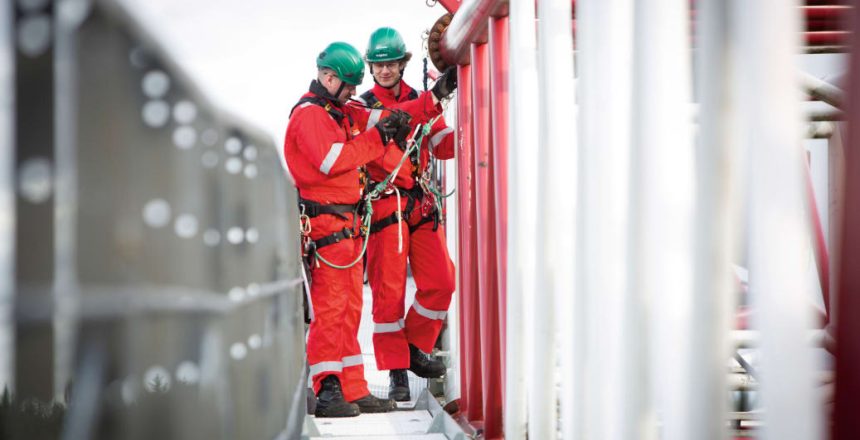Introduction to the Working at Height Regulations
Lloyds British International have put together a brief guide of the working at height regulations that describes what you, as an employer, what you need to do to protect your employees from falls from height.
This guide would also prove useful for company employees and company representatives. Following this guidance is normally enough to comply with the Work at Height Regulations 2005 (WAHR). You are free to take other action, except where the guidance says you must do something specific. Falls from height are one of the biggest causes of workplace fatalities and major injuries. Common causes are falls from ladders and through fragile roofs.
The purpose of Working at height regulations is to prevent death and injury from a fall from height. Work at height means work in any place where, if there were no precautions in place, a person could fall a distance liable to cause personal injury.
When considering the precautions for work at height we advise on taking the sensible approach. There may be some low-risk situations where common sense tells you no particular precautions are necessary and the law recognises this. For example working on a step ladder. Please note that there is a common misconception that ladders and stepladders are banned, but this is not the case. There are many situations where a ladder is the most suitable equipment for working at height
What to do before Working at Height?
- Do as much work as possible from the ground
- Ensure workers are able to move safely and easily too where they are working at height
- Ensure that the equipment that is in use is suitable, stable and strong and has also been maintained and checked correctly
- Ensure you aren’t going to overload or have to overreach when working at height.
- Take extra precaution when working near fragile surfaces
- Ensure you are protected from the consequences of a falling object
- Ensure you know the emergency evacuation and rescue procedures if applicable
Who do the Working at Height Regulations apply to and how to comply with them.
If you are an employer or you control activities that involve working at height then the regulations apply to you. How do you comply with the regulations though?
Employers and individuals who are in control of any work at height activity must make sure work is properly planned, supervised and carried out by competent people. This generally involves using the right type of equipment for working at height. However Low-risk, relatively straightforward tasks will require less effort when it comes to planning. Employers and those in control must first assess the risks and minimise them.
Ensure to take a sensible approach when considering precautions for work at height. Factors to weigh up include the height of the task; the duration and frequency; and the condition of the surface being worked on. There will also be certain low-risk situations where common sense should tell you no particular precautions are necessary in this particular situation.
How do you Decide if someone is competent to "Work at Height"
You should make sure that people with sufficient skills, knowledge and experience are employed to perform the task, or, if they are being trained, that they work under the supervision of somebody competent to do it.
In the case of low-risk, short duration tasks (short duration in this case means the working at height tasks take less than 30 minutes) involving ladders, competence requirements may be no more than making sure employees receive instruction on how to use the equipment safely (ie how to correctly tie a ladder or where to position it) and appropriate training.
When a more technical level of competence is required for a job the working at height regulations state “drawing up a plan for assembling a complex scaffold, existing training and certification schemes drawn up by industry bodies to demonstrate competence”
What measures do the working at height regulations suggest should be taken in order to protect people?
The working at height regulations suggest to consider measures that protect everyone who is at risk commonly known as collective protection, before measures that protect only the individual (personal protection).
Collective protection is equipment that does not require the person working at height to act to be effective, for example a permanent or temporary guard rail.
On the other hand Personal protection is equipment that requires the individual to act to be effective. An example of personal protection is putting on a safety harness correctly and connecting it, via an energy-absorbing lanyard, to a suitable anchor point.
What are the most common causes of Accidents when working at height?
Roof work is regarded as a high risk activity as falls from roofs, through fragile roofs and fragile roof lights are one of the most common causes of workplace death and serious injury. As well as in construction, these accidents can also occur on roofs of factories, warehouses and farm buildings when roof repair work or cleaning is being carried out.
The Following are likely to be fragile
- Roof Lights
- Liner Panels
- Non Reinforced Fibre Cement sheets
- Corroded Metal Sheets
- Rotted Chipboard
- Glass
- Slate and Tiles
How do you select the correct equipment for Working at Height
The Working at height regulations state that when selecting equipment for working at height employers must do the following :
- Provide the most suitable equipment appropriate for the scope of work
- Take Account of factors such as working conditions, nature and frequency of working at height, the risks to safety of everyone where the work equipment will be used
How do you ensure the working at height equipment itself is in Good Condition?
Working at height equipment as specific in the working at height regulations, for example scaffolding, needs to be assembled or installed according to the manufacturer’s instructions and in keeping with industry guidelines.
Where the safety of the work equipment depends on how it has been installed or assembled, an employer should ensure it is not used until it has received an inspection by an organisation or individual in the position of a competent person. A competent person is someone who has the necessary skills, experience and knowledge to manage health and safety.
Furthermore, Any equipment exposed to conditions that may cause it to deteriorate, and result in a dangerous situation, should be inspected at suitable and specified intervals where appropriate to the environment and use. Do an inspection every time something happens that may affect the safety or stability of the equipment, eg adverse weather, accidental damage.
You are required to keep a record of any inspection for types of work equipment including: guard rails, toe-boards, barriers or similar collective means of protection; working platforms (any platform used as a place of work or as a means of getting to and from work, eg a gangway) that are fixed (eg a scaffold around a building) or mobile (eg a mobile elevated working platform (MEWP) or scaffold tower); or a ladder.

